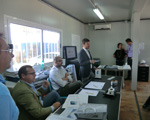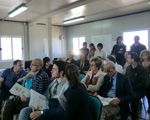 We all know how much important the use of alternative energies is for both the economical saving that they allow and for the respect of the environment. Giem Srl shares with ParchitelloAlta the same thought and decided to equip both the villas and the flats with a solar thermal and photovoltaic plant.
We all know how much important the use of alternative energies is for both the economical saving that they allow and for the respect of the environment. Giem Srl shares with ParchitelloAlta the same thought and decided to equip both the villas and the flats with a solar thermal and photovoltaic plant.
The same can be applied for the block of flats management, whose photovoltaic system is able to ensure the coverage all the Energy demands for the irrigation and lighting plants. Saturday 5th May 2012 the technicians of Selferg and Rotex showed the importance of these equipments to all numerous potential customers who took part to the event:
The solar thermal plant Rotex for sanitary use is installed in every villa and in every flat of the residential complex Parchitello Alta. It is a plant typology that is necessary to get hot water from the power of sun.
This system can supply between the 80% and the 95% of the whole hot water that we usually need in our everyday life. We should also keep in mind that solar plants can supply more than 90% of the hot water needs from April to October, allowing every resident to switch off their boilers.
Particularly in Southern Italy the performances of these systems are excellent also during winter. As far as the yearly saving is concerned, this depends on each family’s private needs and on how much water is used for the personal hygiene or for the housework. With a quite dependable calculation we can state that every single person can save yearly up to 100-180 methane cube meters with a reduction of 230-400kg of CO2 carbon dioxide emission. To these quantities we must add the boilers’ squandering (pilot light, intermittent functioning of the boiler to keep big quantities of water at the right temperature).
These losses are another yearly 150-200 methane cube meters to be added to the yearly savings for each person. Therefore if we consider the costs of methane for each cube meter, the costs for lights, taxes, supplementary taxes, (taxes after the threshold for high consume), VAT and inflation,
it is easier to realize the amount of energy savings that will be achieved. Selferg photovoltaic plant has the function of producing electrical energy to supply one’s own dwelling. These solar plants are able to produce 100% coverage of the electrical needs for one’s own dwelling with a remarkable reduction of bills’ costs.
The yearly need for electrical energy, considering the dimension and the average typology of villas and the average number of people living in them, is around 6.000 kWh/pro year without the use of particular systems for energy saving (such as low consumption lamps…).
The photovoltaic system provided with every villa is 6 kW powerful and produces yearly around 7.800 kWh, therefore it guarantees the complete autonomy in terms of electricity. The owner will also be able to sell the electrical energy produced with it through a system called “feed-in tariff”, or benefits for the amount of energy produced by the user with his/her photovoltaic plants and granted by the company which manages the local electricity supply.
This surplus energy is measured by an electricity meter installed on each plant by the electricity supplier company. The feed-in tariffs are granted for 20 years and amounts to 0.44 Euro/kWh for our villas.
 For a better comparison we should consider that the cost of electricity is today around 0,16 Euro/kW for domestic use, therefore the benefits amount three times the normal cost of electrical Energy.
For a better comparison we should consider that the cost of electricity is today around 0,16 Euro/kW for domestic use, therefore the benefits amount three times the normal cost of electrical Energy.
The installed plant on villas allow the so-called “on site swap” (Energy absorption from the home network and transfer of it according to the needs), therefore to the feed-in tariff we must add the saving of 0,16 Euro/kWh due to the absorbed Energy which is not paid to the electricity supplier.
It is important to notice that the feed-in tariff is fixed for the contract’s length of 20 years and its value will decrease in the years as the result of the effect of inflation.
After these 20 years the electricity produced will be used directly for the private use and the bills’ costs, that will be received, amount to the difference between what the plant will produce during the year and what will be consumed.
We also highlight that a photovoltaic system last more than 20 years: around 40-50 years
In practical terms with this installed photovoltaic systems every villa will be granted these savings in terms of energy:
6.000 yearly produced kWh are equivalent to a savings of: 6.000 kWh x 0,16 €/kWh = 960 €/pro year
1.800 yearly produced and non consumed kWh are equivalent to an earning of: 1.800 kWh x 0,44 €/kWh = 792 €/pro year
With the sold amount of energy we obtain a benefit of:
Around 1.750 €/pro year.
We must also state that the yearly savings in terms of carbon dioxide CO emission in the air for each villa are 6.400 Kg, thanks to the use of the photovoltaic system for the production of electricity obtained directly from the sun. 53 photovoltaic plants will be installed in the residential complex, one plant for each of the 48 villas, and one for each of the 4 blocks of flats for the coverage of the electrical needs of the block of flats itself (lifts, autoclave, stairs’ lights, doorphones…) and a big plant for the coverage of the whole complex services (road lights, irrigation system pumping, phone and data lines…).
The total installed power of these plants will be around 323 kW for a yearly electricity production of around 420.000 kWh. 340.000 Kg of CO2 will not be emitted in the air for each dwelling thanks to the use of the photovoltaic system.